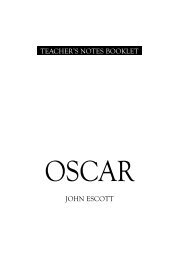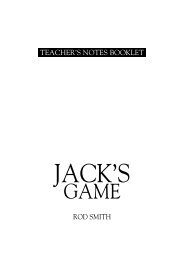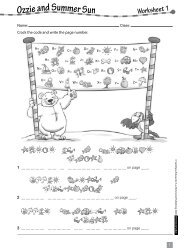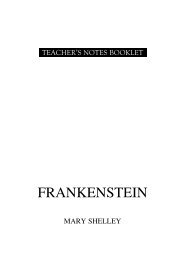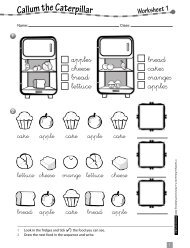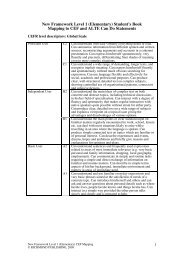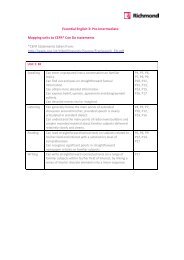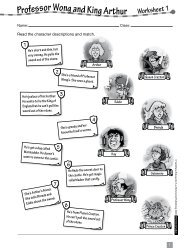Pashto - Supadu
Pashto - Supadu
Pashto - Supadu
You also want an ePaper? Increase the reach of your titles
YUMPU automatically turns print PDFs into web optimized ePapers that Google loves.
SIMON & SCHUSTER’S<br />
®<br />
PIMSLEUR<br />
pashto<br />
reading booklet
Travelers should always check with their<br />
nation's State Department for current<br />
advisories on local conditions before<br />
traveling abroad.<br />
Graphic Design: Maia Kennedy<br />
© and ‰ Recorded Program 2010 Simon & Schuster, Inc.<br />
© Reading Booklet 2010 Simon & Schuster, Inc.<br />
Pimsleur® is an imprint of Simon & Schuster Audio,<br />
a division of Simon & Schuster, Inc. Mfg. in USA.<br />
All rights reserved.
Acknowledgments<br />
<strong>Pashto</strong><br />
Voices<br />
English-Speaking Instructor ...................... Ray Brown<br />
<strong>Pashto</strong>-Speaking Instructor....... Mohammad F. Hakami<br />
Female <strong>Pashto</strong> Speaker ................................ Adela Raz<br />
Male <strong>Pashto</strong> Speaker ................................. Aman Khan<br />
Course Writers<br />
Aman Khan ♦ Joan Schoellner<br />
Editors<br />
Delaram Soltani ♦ Beverly D. Heinle<br />
Reviewer<br />
Hosai Ehsan<br />
<strong>Pashto</strong> Consultant<br />
Dr. Alam Payind<br />
Director of Middle East Studies Center<br />
Ohio State University<br />
Executive Producer<br />
Beverly D. Heinle<br />
Producer & Director<br />
Sarah H. McInnis<br />
Recording Engineers<br />
Peter S. Turpin ♦ Kelly Saux<br />
Simon & Schuster Studios, Concord, MA<br />
iii
For more information,<br />
call 1-800-831-5497 or visit us at<br />
www.Pimsleur.com
TABLE OF CONTENTS<br />
Reading Lessons<br />
Lesson One<br />
Introduction . . . . . . . . . . . . . . . . . . . . . . . . . . . . . . . . .1<br />
Alphabet Chart . . . . . . . . . . . . . . . . . . . . . . . . . . . . . .26<br />
Diacritics . . . . . . . . . . . . . . . . . . . . . . . . . . . . . . . . . . 10<br />
.3<br />
Lesson One . . . . . . . . . . . . . . . . . . . . . . . . . . . . . . . . 11 .4<br />
Lesson Two . . . . . . . . . . . . . . . . . . . . . . . . . . . . . . . . 12 .5<br />
Lesson Three . . . . . . . . . . . . . . . . . . . . . . . . . . . . . . . 13<br />
.6<br />
Lesson Four . . . . . . . . . . . . . . . . . . . . . . . . . . . . . . . . 14<br />
Lesson Five . . . . . . . . . . . . . . . . . . . . . . . . . . . . . . . . 15 .7<br />
Lesson Six . . . . . . . . . . . . . . . . . . . . . . . . . . . . . . . . . 16 .8<br />
Lesson Seven . . . . . . . . . . . . . . . . . . . . . . . . . . . . . . . 17<br />
.9<br />
Lesson Eight . . . . . . . . . . . . . . . . . . . . . . . . . . . . . . . 18<br />
Lesson Nine . . . . . . . . . . . . . . . . . . . . . . . . . . . . . . .<br />
.10<br />
19<br />
Lesson Ten . . . . . . . . . . . . . . . . . . . . . . . . . . . . . . . ..11<br />
20<br />
Lesson Eleven . . . . . . . . . . . . . . . . . . . . . . . . . . . . . ..12<br />
21<br />
Lesson Twelve . . . . . . . . . . . . . . . . . . . . . . . . . . . . . . 22<br />
.13<br />
Lesson Thirteen . . . . . . . . . . . . . . . . . . . . . . . . . . . . . 23<br />
Lesson Fourteen . . . . . . . . . . . . . . . . . . . . . . . . . . . ..14<br />
24<br />
Lesson Fifteen . . . . . . . . . . . . . . . . . . . . . . . . . . . . . ..15<br />
25<br />
Lesson Sixteen . . . . . . . . . . . . . . . . . . . . . . . . . . . . . 26<br />
.16<br />
Lesson Seventeen . . . . . . . . . . . . . . . . . . . . . . . . . . . 27<br />
Lesson Eighteen . . . . . . . . . . . . . . . . . . . . . . . . . . . ..17<br />
28<br />
Lesson Nineteen . . . . . . . . . . . . . . . . . . . . . . . . . . . ..18<br />
30<br />
Lesson Twenty . . . . . . . . . . . . . . . . . . . . . . . . . . . . ..19<br />
32<br />
.20<br />
v
pashto<br />
Lesson Introduction 1<br />
<strong>Pashto</strong> is an Iranian language of the Indo-<br />
European family. There are over 17 million speakers<br />
of <strong>Pashto</strong>, primarily in Afghanistan and Pakistan. In<br />
Afghanistan, it is one of the two official languages<br />
and it is the native tongue of approximately 35% of<br />
the population. The other official language, Dari<br />
(Persian), is spoken by about 50%. Although <strong>Pashto</strong><br />
is an official language of Afghanistan and is a required<br />
subject in middle school, Dari is used primarily in<br />
business and higher education. As a result, most<br />
Pashtuns also speak Dari. However, many Dari<br />
speakers do not have a good command of <strong>Pashto</strong>.<br />
<strong>Pashto</strong> is spoken as a regional language by about<br />
17 percent of the population of Pakistan. It is spoken<br />
in the North West Frontier Province (Pakhtoonkhwa),<br />
in the Federally Administered Tribal Areas (FATA),<br />
and in Balochistan. It is also spoken in some Pakistani<br />
cities like Karachi and Hyderabad. <strong>Pashto</strong>, however,<br />
is not an official language in Pakistan (Urdu is the<br />
offical language) and it is not taught in schools.
pashto<br />
Introduction (continued)<br />
Smaller communities of speakers can be found<br />
in Northeast Iran, Tajikistan, India, and the United<br />
Arab Emirates. The major <strong>Pashto</strong>-speaking cities are<br />
Kabul, Jalalabad, Kandahar, Peshawar, and Quetta.<br />
Athough <strong>Pashto</strong> has many dialects, the three<br />
primary ones are:<br />
• Northern - as spoken in Kabul and Jalalabad<br />
(Afghanistan) and in the Northwest Frontier<br />
Province (Pakistan);<br />
• Southern - as spoken in Kandahar (Afganistan)<br />
and Balochistan (western Pakistan and eastern<br />
Iran);<br />
• Central - as spoken in Wazirstan (northern<br />
Pakistan).<br />
These three dialects are mutually intelligible.<br />
This course teaches the northern dialect as spoken in<br />
Kabul, which will be understood through all <strong>Pashto</strong>speaking<br />
regions. <strong>Pashto</strong> is also called Pakhto,<br />
Pushto, Pukhto, Pashtu, or Pushtu. The variation<br />
in spelling reflects the different pronunciations in<br />
different regions; speakers of the northern dialect say<br />
“Pakhto” and speakers of the southern dialect say,<br />
2
pashto<br />
Introduction (continued)<br />
“<strong>Pashto</strong>.” This demonstrates the primary difference<br />
between the southern dialect, which uses /sh/ and<br />
/zh/ sounds, and the northern dialect, which uses<br />
/kh/ and /gh/ sounds instead. The central dialect is<br />
more similar in pronunciation to the southern dialect;<br />
however, vocabulary differs somewhat.<br />
<strong>Pashto</strong> uses a modified version of the Arabic<br />
alphabet, with forty-five letters, as opposed to twentyeight<br />
in Arabic. The first written records of <strong>Pashto</strong><br />
date to the 16 th century. In the 18 th and again in the<br />
20 th century the script was standardized to include<br />
additional letters representing sounds specific to<br />
<strong>Pashto</strong>. <strong>Pashto</strong> does not have capital letters, but uses<br />
an adapted form of Western punctuation. Written<br />
<strong>Pashto</strong> has the following characteristics:<br />
• It is read from right to left, except for numbers,<br />
which go from left to right. <strong>Pashto</strong> letters are<br />
distinguished by one, two, or three dots, which<br />
are placed above or below the letter – or, in some<br />
cases, by the lack of dots.<br />
3
pashto<br />
Introduction (continued)<br />
• As in English handwriting, most <strong>Pashto</strong> letters<br />
connect to those that follow them. However, some<br />
letters, called “non-connectors,” connect only to<br />
letters that precede them.<br />
• When letters connect to a preceding letter, they<br />
often modify their shape, undergoing a reduction<br />
when the two are joined together.<br />
• Some letters also modify their shape according<br />
to their position in a word – depending on whether<br />
they appear in initial, medial, or final position.<br />
• In standard written <strong>Pashto</strong>, the so-called “short<br />
vowels” are usually omitted. They may be represented<br />
by diacritical marks, as they are in these<br />
reading lessons. The three “long vowels,” however<br />
are separate letters and are always included.<br />
• The appearance of some letters may vary,<br />
depending on the choice of font.<br />
A complete listing of the <strong>Pashto</strong> alphabet and the<br />
diacriticals follows, starting on page 6. You should<br />
use this chart for reference only, as all the information<br />
you need to do the readings is contained on<br />
the audio.<br />
4
pashto<br />
Introduction (continued)<br />
There are twenty <strong>Pashto</strong> reading lessons recorded<br />
at the end of the program. You may choose to do the<br />
readings along with the units, starting with Unit 11,<br />
or all together after completing the rest of the course.<br />
Feel free to repeat the reading lessons as often as<br />
necessary for practice with the <strong>Pashto</strong> alphabet and<br />
the sounds the letters represent.<br />
Some of the words and phrases you will read<br />
are taught in this course, but many are not, and ---<br />
especially in the early lessons --- a number of them<br />
are simply syllables rather than actual words. Actual<br />
words are used more and more as the number of<br />
letters introduced increases, and in the final lessons<br />
you will be understanding much of what you read.<br />
5
pashto<br />
(Read from right to left.)<br />
6<br />
<strong>Pashto</strong> Alphabet Chart<br />
Isolated End Middle Beginning Name Spelling<br />
الف alef ا ا ا آ ,ا<br />
بې be ب ب ب ب<br />
پې pe پ پ پ پ<br />
تې te ت ت ت ت<br />
tte ټ ټ<br />
ثې Se ث ث ث ث<br />
جيم jeem ج ج ج ج<br />
مي<br />
ځ<br />
zeem or<br />
Ze<br />
چې Che چ چ چ چ<br />
مي<br />
څ<br />
alpha chart tte page 6<br />
alpha chart kheen page 7 of alphabet chart<br />
seem or<br />
se or ce<br />
#"!<br />
%$<br />
حې he ح ح ح ح<br />
خې khe خ خ خ خ<br />
دال dal د د د د<br />
ډال ddal ډ ډ ډ ډ
pashto<br />
<strong>Pashto</strong> Alphabet Chart (continued)<br />
(Read from right to left.)<br />
Isolated End Middle Beginning Name Spelling<br />
ذ<br />
ذ ذ ذ Zaal ذال ر<br />
ر ر ر re رې ړ<br />
ړ ړ ړ rhe ړې ز<br />
ز ز ز zhe زی ژ<br />
ژ ژ ژ zze ږ<br />
ږ ږ ږ ge ږې سین seen س س س س<br />
شین sheen ش ش ش ش<br />
kheen ښ ښ<br />
ص<br />
ص ص ص swat صات ض<br />
ض ض ض zwat ضات ط<br />
ط ط ط twe طوې ظ<br />
ظ ظ ظ zwe ظوې ع<br />
ع ع ع ain عني 7<br />
alpha chart tte page 6<br />
alpha chart kheen page 7 of alphabet chart<br />
#"!<br />
%$
pashto<br />
<strong>Pashto</strong> Alphabet Chart (continued)<br />
(Read from right to left.)<br />
Isolated End Middle Beginning Name Spelling<br />
غني ghain غ غ غ غ<br />
فې fe ف ف ف ف<br />
قاف qaf ق ق ق ق<br />
alpha chart gaf page 8<br />
gaf beginning:<br />
کاف kaf ك "& ك <br />
alpha chart gaf page 8<br />
gaf middle<br />
gaf beginning:<br />
#"! gaf "& "'" ګ<br />
gaf middle<br />
الم lam ل ل ل ل<br />
"'"<br />
م م م م<br />
meem or<br />
ميم miim<br />
نون noon ن ن ن ن<br />
نوڼ noorh ڼ<br />
ه ه ه ه<br />
he or<br />
rounded<br />
he<br />
هې<br />
واو waw و و و و<br />
ي ي ي ي<br />
strong<br />
سخته یی ye<br />
یی ye ی ی ی ی<br />
8
pashto<br />
<strong>Pashto</strong> Alphabet Chart (continued)<br />
(Read from right to left.)<br />
Isolated End Middle Beginning Name Spelling<br />
پسته یی soft ye ې ې ې ې<br />
ۍ<br />
ئ<br />
ۍ<br />
ئ<br />
feminine<br />
ye<br />
Lesson 13 page 24<br />
#11<br />
verbal<br />
ye<br />
hehamza<br />
wawhamza<br />
ړواله یی<br />
هې حمزه<br />
واو حمزه<br />
ۀ ۀ<br />
ؤ ؤ ؤ ؤ<br />
alpha chart feminine ye page 9<br />
-,<br />
+*)($<br />
10/&.<br />
9
َ<br />
ُ<br />
pashto<br />
(Read from right to left.)<br />
Diacritics<br />
Diacritic Name Spelling<br />
ِ<br />
zwar (above letter)<br />
zer (below letter)<br />
pekh (above letter)<br />
زور<br />
زیر<br />
ښ<br />
ٓ<br />
مَد alef) mad (only above initial<br />
hamza (only in combination<br />
with waw and<br />
ٔ<br />
حمزه he)<br />
There is a fourth diacritic, called zwarakay, which<br />
is rarely used in Pakhto. It is shown as a horizontal<br />
line above a consonant and makes a schwa sound.<br />
,ال,combination In <strong>Pashto</strong> there is a special letter<br />
called lam alef la, which represents the letter lam<br />
followed by alef.<br />
10
pashto<br />
Lesson One<br />
(Read from right to left.)<br />
.11<br />
ا<br />
زازا<br />
.1<br />
دا 12.<br />
آد<br />
.2<br />
داد 13.<br />
آز<br />
.3<br />
دادا 14.<br />
آدا<br />
.4<br />
زا 15.<br />
آداز<br />
.5<br />
داز 16.<br />
آزا<br />
.6<br />
زاد 17.<br />
آزاد<br />
.7<br />
8. دازا 18. زدا<br />
9. زادا 19. آزدا<br />
10. زاز 20. دازدا<br />
11
pashto<br />
Lesson One Two<br />
(Read from right to left.)<br />
دازاد 11.<br />
ساز<br />
.1<br />
را 12.<br />
آسار<br />
.2<br />
راز 13.<br />
آدزار<br />
.3<br />
زارد 14.<br />
دازار<br />
.4<br />
راد 15.<br />
زاسا<br />
.5<br />
دار 16.<br />
سادزار<br />
.6<br />
زار 17.<br />
سادا<br />
.7<br />
8. رازاد 18. رازا<br />
9. سا 19. زارا<br />
10. سارا 20. رازدا<br />
12
pashto<br />
Lesson Three One<br />
(Read from right to left.)<br />
ساراد 11.<br />
باد<br />
.1<br />
سازا 12.<br />
بادساز<br />
.2<br />
شا 13.<br />
سَ بز<br />
.3<br />
شارد \ سارد 14.<br />
سَ رشار<br />
.4<br />
زاشار 15.<br />
سَ رشَ ر<br />
.5<br />
.16<br />
زَ<br />
دَبرا<br />
.6<br />
زَرد 17.<br />
باب<br />
.7<br />
8. سَ ر 18. آس<br />
9. دَرس 19. برَش<br />
10. سَ ز 20. زَرشاد<br />
13
pashto<br />
Lesson Four One<br />
(Read from right to left.)<br />
شارسار 11.<br />
بازوو<br />
.1<br />
سَ ردار 12.<br />
اَسب<br />
.2<br />
شاباش 13.<br />
ستَرتوب<br />
.3<br />
بَربَر 14.<br />
تاسو<br />
.4<br />
بَرادَر 15.<br />
دوست<br />
.5<br />
شو 16.<br />
اَرساب<br />
.6<br />
داروو 17.<br />
توت<br />
.7<br />
8. تَش 18. تَر<br />
9. تَت 19. ستا<br />
10. شَ ربَت 20. سَ با<br />
14
pashto<br />
Lesson One Five<br />
(Read from right to left.)<br />
تَبَر 11.<br />
پاپ<br />
.1<br />
تَشناب 12.<br />
پوی<br />
.2<br />
آبشار 13.<br />
اِسرار<br />
.3<br />
ديد 14.<br />
اِبراز<br />
.4<br />
تَرتيب 15.<br />
پیشو<br />
.5<br />
سیر 16.<br />
توپ<br />
.6<br />
دیرش 17.<br />
اِزدا<br />
.7<br />
8. تیز 18. پور<br />
9. دی 19. تَپوس<br />
10. پاس 20. پاتا<br />
15
pashto<br />
Lesson One Six<br />
(Read from right to left.)<br />
باتور 11.<br />
باز<br />
.1<br />
ستوری 12.<br />
حاسِ د<br />
.2<br />
بریت 13.<br />
احباب<br />
.3<br />
بيزو 14.<br />
ستاسو<br />
.4<br />
نادان 15.<br />
اِحسان<br />
.5<br />
نون 16.<br />
یا<br />
.6<br />
اَنا 17.<br />
زَبَح<br />
.7<br />
8. پَر 18. تَسبیح<br />
9. تَن 19. نادر<br />
10. تیزاب 20. راحَ ت<br />
16
pashto<br />
Lesson Seven One<br />
(Read from right to left.)<br />
سپور 11.<br />
لو<br />
.1<br />
پَیدا 12.<br />
الر<br />
.2<br />
آپَرین 13.<br />
پلَن<br />
.3<br />
بَند 14.<br />
تَلوار<br />
.4<br />
آوار 15.<br />
استَوَل<br />
.5<br />
اِتوار 16.<br />
بُلبُل<br />
.6<br />
دُنیا 17.<br />
تلَل راتلَل<br />
.7<br />
8. بُت 18. حَ الل<br />
9. بُنیر 19. یار<br />
10. لِباس 20. او تاسو؟<br />
17
pashto<br />
Lesson Eight One<br />
(Read from right to left.)<br />
سیرینا 1.<br />
کلَک 11.<br />
شین 12.<br />
کالِج<br />
.2<br />
بایَد 13.<br />
صابُون<br />
.3<br />
جَ بَر 14.<br />
حِ صار<br />
.4<br />
جَ دَ ل 15.<br />
حِ رَ ص<br />
.5<br />
وَ جَ ل 16.<br />
صَ ندَل<br />
.6<br />
تاج 17.<br />
صاحِ ب کار<br />
.7<br />
8. کابُل 18. دیوال<br />
9. کالبُوت 19. حاجَ ت<br />
10. اِنکار 20. پرَجنیدَل<br />
18
pashto<br />
Lesson Nine One<br />
(Read from right to left.)<br />
بازار 1.<br />
شَ م 11.<br />
لَرَل 12.<br />
امان<br />
.2<br />
صاد 13.<br />
کَله؟ اُس؟<br />
.3<br />
هاها 14.<br />
شَ ک<br />
.4<br />
هَ ر 15.<br />
دیارلَس<br />
.5<br />
بَجه 16.<br />
هَلته دی؟<br />
.6<br />
زَره 17.<br />
مَنَنه.<br />
.7<br />
8. سَ هَ ر 18. ما سَ ره<br />
9. ميم 19. لَرَم<br />
10. زه هَم. 20. نَه، لَس زَره نه.<br />
19
pashto<br />
Lesson One Ten<br />
(Read from right to left.)<br />
بَس بِیا / بس بیا 11.<br />
یور<br />
.1<br />
اتَلَس سَ وه 12.<br />
لیک<br />
.2<br />
Lesson<br />
Lesson<br />
10,<br />
10,<br />
#14<br />
#14<br />
page<br />
page<br />
21<br />
21<br />
آسَ الم 13.<br />
کَوئ<br />
.3<br />
Lesson<br />
Lesson<br />
10,<br />
10,<br />
#15<br />
#15<br />
page<br />
page<br />
21<br />
21<br />
$#"!<br />
.4 امریکایي .14<br />
$&%!<br />
.5 يئ .15<br />
6. شئ 16. سیند<br />
7. نَسواري 17. دي<br />
8. بَجې 18. یَویشت<br />
9. یُونان 19. پریوَتَل<br />
10. صَ حي 20. زیاتې<br />
20
pashto<br />
Lesson Eleven One<br />
(Read from right to left.)<br />
نَن، نه. 11.<br />
وَخت<br />
.1<br />
په نَهه بَجې. 12.<br />
شوخ<br />
.2<br />
.3 غَرمې .13<br />
4. غَ م 14.<br />
.5 داغ .15<br />
باغ 16.<br />
سَ خت<br />
.6<br />
باغوان 17.<br />
نیم كیلو<br />
.7<br />
8. خُ وشه 18. خَ بَره<br />
9. خُ ورې 19. مِ رَباني<br />
10. تَخت 20. زه امریکایي یَم.<br />
21
pashto<br />
Lesson 11 page 23<br />
# 11<br />
(Read from right to left.)<br />
#"!<br />
.11<br />
Lesson Twelve One<br />
1. په جِ هاز کې<br />
#13<br />
#12<br />
#('&%$<br />
2. زه بایَد 12.<br />
#13<br />
#13<br />
#15<br />
#15<br />
#15<br />
.'+-<br />
,+!*)<br />
,+!*)<br />
.0/ .'+-<br />
.0/ .'+-<br />
,+!*)<br />
زه به هَم.<br />
.0/<br />
.13<br />
.14<br />
.15<br />
زه باید کار وکَم.<br />
چا<br />
چیرته<br />
.3<br />
.4<br />
.5<br />
6. پَرچَ م 16. تایمَني<br />
7. چایې 17. په تایمَني سَ رَک<br />
8. چَ مَ چ 18. په سیرینا هول کې.<br />
9. ُول 19. په کسي کې.<br />
10. واټ 20. دا واخلئ.<br />
22
alpha chart feminine ye page 9<br />
Lesson 13 page 24<br />
#11<br />
-,<br />
+*)($<br />
10/&.<br />
pashto<br />
(Read from right to left.)<br />
.11<br />
Lesson Lesson Thirteen One<br />
1. سَ بایي دې په خیر<br />
#12<br />
&,+*)('$<br />
2. سَ ودا 12.<br />
#14<br />
#12<br />
.3 رُوسته .13 باره کې 2")10/.- &,+*)('$ 54/43<br />
#14<br />
54/43 2")10/.-<br />
.4 فال .14<br />
#15<br />
#16<br />
746<br />
.5 فاني .15<br />
# 16<br />
# 16<br />
432<br />
5432<br />
276 54322746<br />
.6 افغان .16<br />
Lesson Fifteeen page 26 Lesson Fifteeen page 26<br />
#9<br />
#9 #17<br />
6/$ 97+8 6/$<br />
7. زه افغان یَم. 17.<br />
8. هَ دَف 18. ږیره<br />
افغانی خوَراک 19. هَر کَله<br />
Lesson 13, Page 24<br />
.9<br />
#10<br />
20. هر کله راشئ.<br />
#"!<br />
.10<br />
23<br />
#11
pashto<br />
Lesson Lesson Fourteen One<br />
(Read from right to left.)<br />
ناوَخته 11.<br />
ذَبَح<br />
.1<br />
دا ستاسو دَ پاره. 12.<br />
ذَره بین<br />
.2<br />
ظالِم 13.<br />
کاغَذ<br />
.3<br />
14. عادَت<br />
Lesson 14, page 25<br />
4. حَ ظ<br />
#5<br />
15. مَعلُومات<br />
"!<br />
.5<br />
16. دُعا<br />
#6<br />
'&%$#<br />
'&%$#<br />
.6<br />
#7<br />
17. تعداد<br />
#7<br />
+%*)(<br />
+%*)(<br />
.7<br />
8. ظَ رَ ف 18. دا یک ده.<br />
ُ ل 19. اُستاد<br />
.9<br />
20. زه اُستاد یَم.<br />
24<br />
10. ذات
pashto<br />
Lesson Fifteen One<br />
(Read from right to left.)<br />
کالدارې 11.<br />
رَمضان<br />
.1<br />
آسَ الم علیکُم. 12.<br />
حَ وض<br />
.2<br />
13. مَضمُون<br />
Lesson 15, Page 26<br />
3. ين<br />
#4<br />
14. اِمضا<br />
$#"!<br />
.4<br />
#18<br />
5. َتو 15. ډیر<br />
6. پوښ 16. ډول / دال<br />
7. ضِ د 17. ډوډۍ<br />
#19<br />
---<br />
'&"% '&"%<br />
0/"* --- .&+-, 0/"* +*)( .&+-,<br />
#19<br />
.18<br />
.19<br />
# 16<br />
Lesson Fifteeen page 26<br />
+*)(<br />
#9<br />
432 زَما / ضَ رَر<br />
5432<br />
6/$<br />
.8<br />
.9<br />
10. بُغُ ض 20. ډوډۍ خوَرئ؟<br />
25
اِثبات \ افتاب<br />
pashto<br />
Lesson Lesson Sixteen One<br />
Lesson 16, Page 27<br />
(Read from right #1 to left.)<br />
.11<br />
.$'<br />
&% $#"!<br />
.1<br />
#14<br />
دَ خُ دائ په امان. 12.<br />
بَحث<br />
.2<br />
قیمَت 13.<br />
ومره؟<br />
.3<br />
&+*)(<br />
.4 قَرض .14<br />
قَلَم 15.<br />
تاسو چایې کئ ؟<br />
.5<br />
َ<br />
6. شَ فقَت 16.<br />
7. قاچاق 17. پایدَل<br />
8. ضَ رَ ر 18. ډیره مَنَنه.<br />
9. ثاني 19. سَ با جُ معه ده.<br />
خَ بَره نه ده.<br />
.10 اثاث .20<br />
26
pashto<br />
Lesson Seventeen page 28<br />
#3<br />
#12<br />
(Read from right to left.)<br />
باړ<br />
1987&<br />
%$#"!<br />
.11<br />
.12<br />
Lesson Lesson Seventeen One<br />
مُحتَرَم<br />
َ لور<br />
.1<br />
.2<br />
Lesson Seventeen page 28<br />
13. ډالَرو<br />
#3<br />
1987&<br />
.3<br />
#12<br />
14. او په ډالرو کې؟<br />
.4 طوفان %$#"!<br />
%$#"!<br />
5. خَ ط 15. غواړو<br />
#16<br />
.16"5432<br />
,1"0($/<br />
.-","+<br />
6. خَ طاط 16.<br />
#18<br />
7. خَ طَ رناک 17. لَس بَجې دي.<br />
Lesson 17, Page 28<br />
A@? .>-"!<br />
.+<br />
.=<br />
pashto<br />
Lesson Lesson Eighteen One<br />
(Read from right to left.)<br />
1. په اخِ ر کې<br />
28<br />
دَ ولو نه اوَل<br />
هَر چیرته<br />
کَله کَله<br />
اتۀ<br />
وأ<br />
وادۀ<br />
پسهٔ<br />
كُ ڼ<br />
ؤیل<br />
.2<br />
.3<br />
.4<br />
.5<br />
.6<br />
.7<br />
.8<br />
.9<br />
.10
pashto<br />
Lesson Eighteen Lesson (continued) One<br />
(Read from right to left.)<br />
Lesson 18, Page 30<br />
11. ؤَنه<br />
#12<br />
#14<br />
Lesson 18, Page 30<br />
#12<br />
#15<br />
#14<br />
#15<br />
654 32 1.0/<br />
&%"$#"!<br />
واؤ &%"$#"! +*)('<br />
+*)('<br />
.,*-,<br />
.12<br />
.13<br />
.14<br />
.15<br />
زَما نُوم امان دی.<br />
خوشاله<br />
ستاسو په لیدو ---<br />
ستاسو په لیدو ډیر خوشاله شوم.<br />
مرباني، ستاسو ډیره مننه.<br />
29<br />
.16<br />
.17<br />
.18<br />
.19<br />
.20
Lesson 19, Number One<br />
pashto<br />
Lesson Lesson Nineteen One<br />
(Read from right to left.)<br />
,<br />
+*<br />
)"( '$&<br />
%<br />
$#"!<br />
.1<br />
7/21/10 lh<br />
َتونِستان<br />
زه د تونستان یم.<br />
او تاسو؟<br />
.2<br />
.3<br />
.4<br />
---<br />
*)('&%<br />
$#<br />
"!<br />
.5<br />
.5<br />
.5<br />
/<br />
; :&59 $8 $7654<br />
; :&9<br />
$8 $764<br />
.10/'.)-<br />
,+<br />
*('&%<br />
$#<br />
"!<br />
/ ; :&59 $8 $7654 &'32<br />
&'32<br />
&'32<br />
1)?-&> =5
pashto<br />
.1?-&><br />
Lesson Nineteen Lesson (continued) One<br />
(Read from right to left.)<br />
;E4 .1<br />
.8<br />
$63Q&T .10<br />
31<br />
=
pashto<br />
Lesson Twenty One<br />
(Read from right to left.)<br />
1. آ سالمُ علیکم.<br />
Lesson 20, Page 33<br />
#3<br />
#8<br />
#10<br />
وعلیکمُ اسالم.<br />
---<br />
('&% $# "!<br />
210/.-&,+*<br />
تلې ده؟ (&<br />
او. سیده الړ شئ.<br />
ډیر لَرې نه دی.<br />
.2<br />
.3<br />
.4<br />
.5<br />
.6<br />
Lesson 20, Page 33<br />
#3<br />
#8<br />
#10<br />
--- ومره لرې دی؟<br />
('&%<br />
$#<br />
"!<br />
210/.-&,+* &)<br />
.7<br />
.8<br />
9. زه معلُومات نه لرم ---<br />
210/.-&,+*<br />
15!<br />
4&3<br />
.10<br />
#11<br />
32
#11<br />
pashto<br />
Lesson Twenty Lesson (continued) One<br />
(Read from right to left.)<br />
---<br />
210/.-&,+*<br />
>=+
For more information,<br />
call 1-800-831-5497 or visit us at<br />
www.Pimsleur.com



